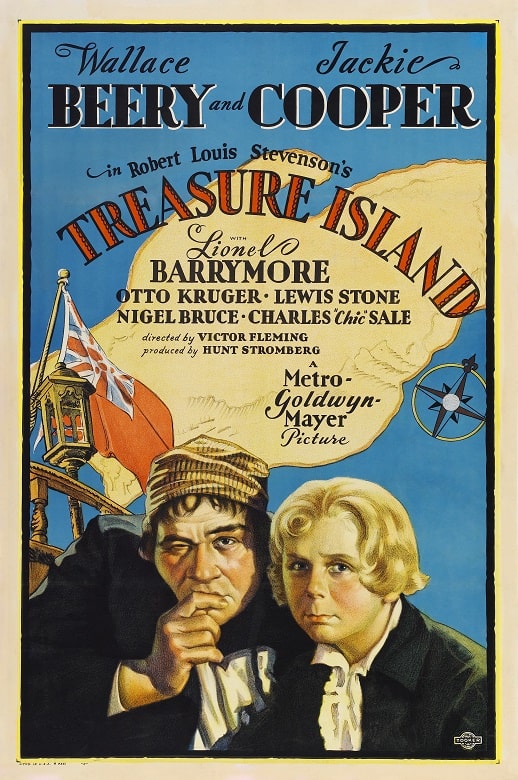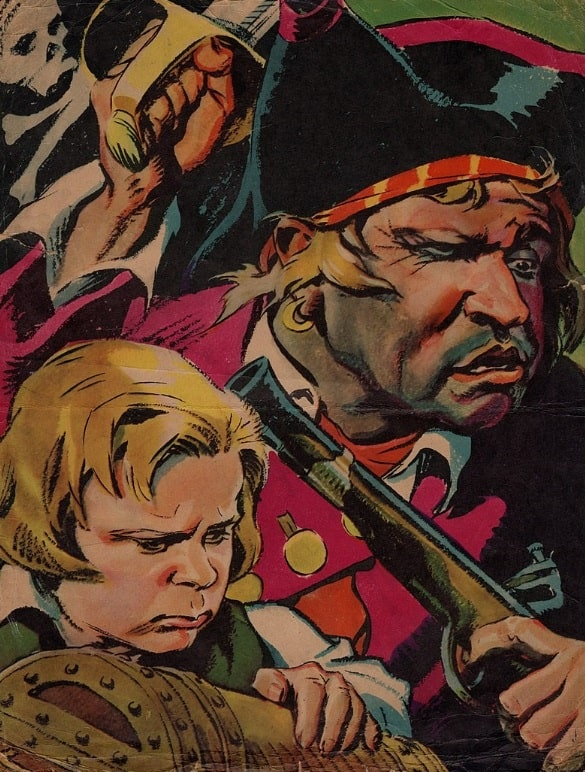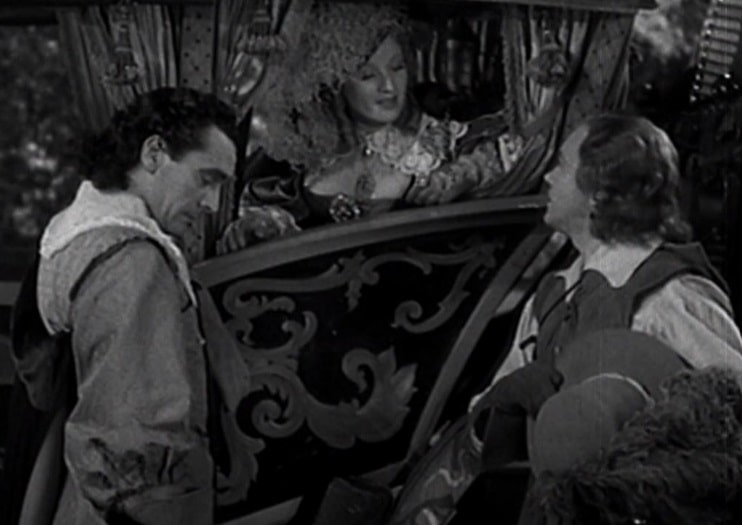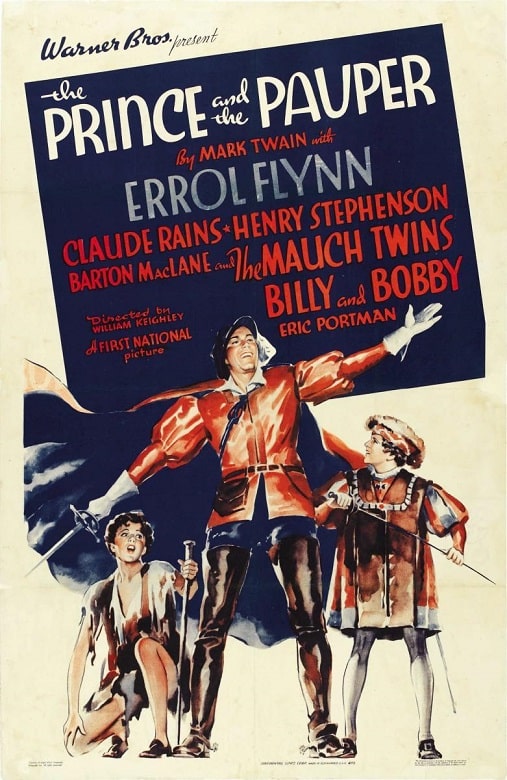Ellsworth’s Cinema of Swords: Swashbucklin’ Talkies
Treasure Island (1934)
Swords in hand, swashbucklers strode across the silver screen throughout the silent era, especially in the Twenties, when Hollywood budgets grew large enough to encompass grand historical spectacles. Then sound came in circa 1930, and swashbucklers went out, in part because early microphones didn’t record well outside, so most of the first “talkies” were filmed on interior sound stages — not the best venues for historical action.
But historical adventure films were saved by the insatiable American (and for that matter, European) appetite for Westerns. Rootin’, tootin’ horse operas had to be shot outside, so the problem of miking away from a sound stage had to be solved. By 1934, the technical issues had been sorted out, and swashbucklers were back on the screen, led by a trio of hits in The Count of Monte Cristo, The Scarlet Pimpernel, and the first talkie version of Treasure Island. This week we’re going to enjoy a look at the latter, and follow it up with two other notable Thirties swashbucklers.
Treasure Island (1934)
Rating: *****
Origin: USA
Director: Victor Fleming
Source: Warner Bros. DVD
Robert Louis Stevenson’s classic 1883 novel established the entire genre of pirate swashbucklers, so naturally it had been filmed in the silent era — five times, in fact. However, none of those older films have survived, so the earliest adaptation we have is this one — but this one’s all we need. It’s a wonderful film that has a lot going for it, but what makes it endlessly rewatchable is the larger-than-life performance of Wallace Beery as Long John Silver.
Conversely, it has one major liability that, despite Beery’s best efforts, makes the modern viewer cringe and wince: the inclusion of child actor Jackie Cooper as young Jim Hawkins. To be fair, Cooper delivered exactly what was asked of him, which was to be painfully over-earnest and sentimental, like every other Thirties child star. It’s just that by current standards and sensibilities, the performances of this period’s child actors — Jackie Cooper, Shirley Temple, and their ilk — are so god-damned grating that you just want to fast-forward right past them.
All right, we got that little rant out of the way. On to the movie: Treasure Island is a pretty close adaptation of Stevenson’s novel, which means it starts slowly, with the first act that establishes the backstory centered on the fugitive pirate Billy Bones at the Admiral Benbow Inn. Fortunately, this production has the great Lionel Barrymore (brother of John) in the role of Billy Bones, and he leaves no scenery unchewed in a bravura performance that ends in his death from equal parts terror and rum. But in death he unwittingly bequeaths to Jim Hawkins the map to the plunder buried on Treasure Island, and avast! We’re off to the Caribbean.
But how to get there, eh? Eh? Enter Squire Trelawney as played by Nigel Bruce (later to be Dr. Watson to Basil Rathbone’s Sherlock Holmes — harrumph, harrumph!). He takes Jim off to Bristol Port, perfectly depicted with a forest of masts above a row of docked ships. On the wharf there we meet Long John Silver, and from that point the rest of the film belongs to Wallace Beery. Silver is the original engaging scoundrel, and Beery plays him broad, smiling, squinting, rolling his eyes and looking around furtively, making sure the audience is in from the beginning on the joke of his duplicity. Young Jim and Squire Trelawney are completely hornswoggled, allowing Silver to pack the crew of the Hispaniola with pirates. But Captain Smollett (craggy Lewis Stone) isn’t fooled by Silver’s smarmy ways and spots him as a cunning rogue.
But by that time, they’ve arrived at Treasure Island, and it’s mutiny, mates, so serve out the cutlasses! The plot adheres closely to the twists and rapid reversals of the novel, and the action scenes are staged well, their imagery striking and memorable. The tense scene in which Jim Hawkins is pursued around the drifting Hispaniola by a wounded pirate, Israel Hands, is particularly fine. One can almost forgive the swab for letting Jackie Cooper survive!
Incidentally, they used a genuine three-master for the Hispaniola, a beautiful ship, filming key scenes at sea, so the sailing’s all true to life and the episodes shot high in the rigging are dizzying. And cackling, mad old Ben Gunn is the real treasure of the island. What a classic! Immortal line: “Them that die’ll be the lucky ones!”
The Three Musketeers (1935)
Rating: ***
Origin: USA, 1935
Director: Rowland V. Lee
Source: Vertice Cine DVD
This is the first English-language “talkie” version of Alexandre Dumas’s classic story, which means it’s also the first version with an integrated musical score, and the soundtrack, by the great Max Steiner, is arguably the best Musketeers music ever written. Steiner had been laboring in the Hollywood trenches for years before he finally broke through with his score for King Kong in 1933, and still riding on that high, his music for The Three Musketeers is confident, muscular, and catchy — the main march even has lyrics so the musketeers can sing it as they stride, triumphant, through Paris after defeating the Cardinal’s Guards! If you’re into this sort of thing, the soundtrack is well worth seeking out, in the original or a re-recorded version.
Beyond that, there’s not much about this adaptation that’s really memorable. Studio RKO usually turned out second-rate B-movies, and though this was an expensive production for them, it’s not exactly up to Warner Bros. standards. Most of the cast are journeyman actors who are now forgotten, the only real standout being the fine Hungarian actor Paul Lukas in the role of Athos.
D’Artagnan is played by Walter Abel, a silent screen star who’d made the transition to talkies but still lets his unsubtle facial expressions do most of the acting work — which is just as well, as he has scarcely any lines for the first twenty minutes, just gapes in naïve wonder at the marvels of Paris. He also just mimes romance with the bland Heather Angel as Constance, but nonetheless you’re still kind of embarrassed for him by how badly he gets conned late in the film by Margot Grahame as the arch-villain Milady de Winter. He gets tied up and carried off in Milady’s carriage, and Athos, Porthos, and Aramis have to rescue the poor sap.
The plot of The Three Musketeers, of course, is incredibly sturdy, and will stand any amount of manhandling. It’s pretty much played straight here, as usual covering only the first half of the novel, the affair of the queen’s diamonds, streamlined to keep the running time under 95 minutes. There are two carriage chases through the eucalyptus woods of southern California and some mediocre fencing, but it all ends in a surprisingly well-staged duel between d’Artagnan and Rochefort (Ian Keith, meh). Kudos for that to director Rowland V. Lee, who had gotten this job based on his helming the previous year of the hit version of The Count of Monte Cristo for United Artists. He’ll go on to direct Monte Cristo sequels and Charles Laughton in Captain Kidd (1945).
Special treat for Musketeer nerds: Nigel de Brulier plays Cardinal Richelieu, a role he’d enacted twice before, in the Douglas Fairbanks silent versions of The Three Musketeers (1921) and The Iron Mask (1929). In looks, at least, he was the Cardinal incarnate.
The Prince and the Pauper (1937)
Rating: ***
Origin: USA, 1937
Director: William Keighley
Source: Warner Bros. DVD
Thirties child actors: threat or menace? Warner Bros. had the cloying Mauch twins, Bobby and Billy, under contract, and bought the rights to Mark Twain’s 1881 novel, The Prince and the Pauper, as a vehicle for them — and after his success in The Charge of the Light Brigade (1936), they threw in their new action hero, Errol Flynn, for good measure.
Flynn plays Miles Hendon, a down-at-his-heels gentleman who takes in the prince (Bobby, or maybe Billy) after he’s been switched with the pauper (Billy, or maybe Bobby). The film actually follows the novel’s plot pretty closely, which means Flynn doesn’t come onstage for nearly an hour, a considerable wait. Fortunately, not all of that hour is wasted on the twins, as much of the time is spent with Claude Rains, well-cast as the suave villain of the piece, the Earl of Hertford.
The presence of Flynn and Rains notwithstanding, this movie is mainly a kids’ fable, broadly played, but adults can still enjoy the fine Tudor-period costumes, Flynn’s indelible charm and charisma, and the occasional razor-sharp line retained from Twain’s novel. The ending is quite absurd — but it’s a fable, isn’t it?
Plus, we get one of Erich Wolfgang Korngold’s best film scores, the main theme of which was so good he reused it as the final movement of his violin concerto. Watch for Fritz Leiber, Sr., as a saintly friar, and enjoy Flynn finally getting to swashbuckle in the last twenty minutes. Guilty pleasure: the execrable Alan Hale, Sr., not yet promoted to the role of Flynn’s Permanent Sidekick, plays a minor villain who comes to a well-deserved bad end.
Where can I watch these movies? I’m glad you asked! Many movies and TV shows are available on disk in DVD or Blu-ray formats, but nowadays we live in a new world of streaming services, more every month it seems. However, it can be hard to find what content will stream in your location, since the market is evolving and global services are a patchwork quilt of rights and availability. I recommend JustWatch.com, a search engine that scans streaming services to find the title of your choice. Give it a try. And if you have a better alternative, let us know.
Previous installments in the Cinema of Swords include:
The Barbarian Boom, Part 4
Blood-Red and Blind: The Crimson Bat
Updating the Classics
Sink Me! Scarlet Pimpernels!
The Barbarian Boom, Part 5
Alexandre/Alexander
Musashi and Kojiro
Forgotten Fantasies
More o’ Zorro
Laugh, Samurai, Laugh
Boarding Party Bingo
They Might Be Giants
Mondo Mifune
LAWRENCE ELLSWORTH is deep in his current mega-project, editing and translating new, contemporary English editions of all the works in Alexandre Dumas’s Musketeers Cycle; the fifth volume, Between Two Kings, is available now from Pegasus Books in the US and UK, while the sixth, Court of Daggers, is being published in weekly instalments at musketeerscycle.substack.com. His website is Swashbucklingadventure.net. Check them out!
Ellsworth’s secret identity is game designer LAWRENCE SCHICK, who’s been designing role-playing games since the 1970s. He now lives in Dublin, Ireland, where he’s a Narrative Design Expert for Larian Studios, writing Dungeons & Dragons scenarios for Baldur’s Gate 3.




Another Ellsworth’s Cinema of Swords? Huzzah!!!
I’ve seen and enjoyed all three of these films, they were favorites of my parents and they made sure that us youngins saw them more than once. Thanks Mom and Dad.
Is it wrong of me to enjoy those times when Mr. Ellsworth’s mask of courtesy is forced to slip by the inanities of some films? “One can almost forgive the swab for letting Jackie Cooper survive!” Now, now, Mr. Ellsworth!